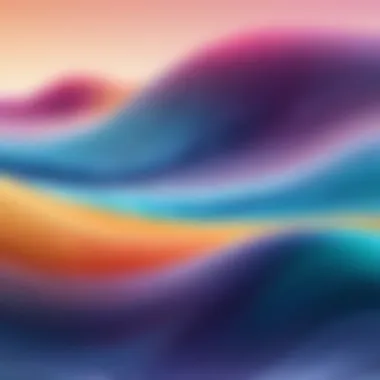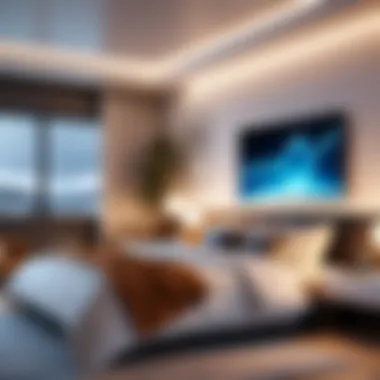The Impact of Sleep-Inducing Videos on Rest


Intro
In today's fast-paced world, where screens abound and obligations seem endless, many are seeking solace through digital means. One avenue that has gained traction is the increasingly popular niche of sleep-inducing videos. These aren't just any videos; they are curated experiences designed to lull the mind and soothe the soul, drawing on various techniques and styles to create the perfect atmosphere for relaxation. As more people grapple with sleep issues, understanding the importance of sleep-inducing videos becomes paramount.
Sleep, a cornerstone of our overall health and well-being, has become a prized commodity, often elusive to those who need it most. Diving into this emerging trend reveals its potential benefits — transforming evening routines, optimizing relaxation, and ultimately fostering better sleep patterns. But how exactly do these videos operate? And, more critically, what makes them successful? Let's embark on this exploration to uncover their immense impact on our daily lives.
Understanding Sleep-Inducing Videos
In a world where the pace of life is ever-increasing, the quest for quality sleep has become more than just a comfort; it's a necessity. Understanding sleep-inducing videos offers valuable insights into how technology can play a role in achieving restorative rest. These videos are designed not only to help someone drift off but also to provide methods of relaxation that are sorely needed in our tech-filled lives. By diving into the specifics, we can recognize the advantages of incorporating such media into our nightly routines.
Definition and Purpose
Sleep-inducing videos encompass a wide range of audiovisual content aimed at facilitating better sleep. Typically, they integrate calming sounds, soothing visuals, or narratives that guide individuals into a more relaxed state, ultimately promoting a smoother transition into sleep. The primary purpose of these videos is to address common issues like insomnia or anxiety which can plague individuals trying to catch some z's.
• Calmness: They are fundamentally meant to create an environment conducive to relaxation. • Distraction: These videos serve to distract the mind from the day's stresses and worries. • Guidance: Many provide gentle guidance or storytelling elements that ease viewers into a peaceful slumber.
Given the information overload prevalent in today's digital landscapes, these videos possess a unique role: They act as a buffer against distraction, directing the viewer's focus towards peaceful and restorative experiences. It's like having a friend softly whispering, "Everything’s okay, just breathe and let go.”
Historical Context
The concept of using audio-visual aids for relaxation is not a novelty born from the boom of YouTube or meditation apps. The roots sink deeper into our cultural practices, reflecting ancient traditions where storytelling and music were pivotal in calming the mind before sleep. For instance, before the age of technology, lullabies sung at bedtime played a fundamental role in preparing a child for rest.
Fast forward to the 20th century, and we see a shift where relaxation tapes and ambient music started gaining popularity. Those tapes served similar purposes, channeling sounds of rain or waves to encourage tranquility. In no time, these primitive forms have transformed into highly curated digital spectacles that blend visuals and sounds seamlessly.
"As the tide of technology ebbs and flows, so does our understanding of rest and relaxation."
Now, with platforms like YouTube and various streaming services, the sheer volume and variety of sleep-inducing content is staggering, allowing users to find the right fit for their personal needs. This intersection of modern life and ancient practices illustrates how sleep-inducing videos are not just a trend; they are part of an evolving narrative on human rest and recuperation.
The Science of Sleep
Understanding the science behind sleep is crucial for grasping how sleep-inducing videos fit into our modern routines. Sleep acts as a natural reset button for both the body and mind. It’s not just an idle state; rather, it plays a significant role in maintaining cognitive function, emotional well-being, and physical health. The necessity for quality sleep cannot be overstated, particularly in an era where many are drowning under the weight of constant distractions. The growing trend of utilizing videos that promote relaxation and sleep demonstrates our adaptation to these challenges, effectively marrying technology with wellness.
Understanding Sleep Cycles
Sleep isn't a one-size-fits-all affair; it’s composed of several phases that contribute to overall restfulness. The cycle is typically categorized into two main types: Non-Rapid Eye Movement (NREM) and Rapid Eye Movement (REM) sleep. Each cycle gives the brain and body time to rejuvenate in different ways.
- NREM Sleep involves three stages:
- REM Sleep is where most dreaming occurs. This stage is essential for emotional regulation and memory consolidation.
- Stage 1: A light sleep where muscle activity slows down, and drifting in and out of consciousness is common.
- Stage 2: Deeper sleep, where the heart rate slows, and body temperature drops.
- Stage 3: The deepest sleep phase, crucial for physical recovery and growth.
Awareness of these cycles can inform how we approach sleep-inducing videos. For instance, a video aimed at guiding listeners into a sleep state might need to align with the natural progression through these phases, emphasizing relaxation and absence of abrupt interruptions. Knowing how to engage with content during these natural rhythms can enhance sleep quality dramatically.
Effects of Technology on Sleep
Technology has a double-edged sword relationship with sleep. On one hand, screens can be the bane of restful slumber, emitting blue light that hinders the production of melatonin—the hormone responsible for sleep. On the other hand, technology also opens the door to various solutions that can enhance sleep quality.
- Positive Effects:
- Negative Effects:
- Guided relaxation: Many sleep-inducing videos offer a structure that can lead users through calming exercises, helping them to unwind.
- Convenience: Access to a myriad of content allows for personalized approaches to achieving better sleep.
- Community Support: Online platforms provide avenues for shared experiences, through forums such as reddit.com, where users discuss effective content.
- Screen time: Late-night binge-watching can disrupt the body’s natural sleep cycle. The addictive nature of visual media can lead to staying up far longer than intended.
- Overstimulation: Not all content is created equal; accidentally finding high-energy shows or generally stimulating content can keep the mind racing when it should be winding down.
In summary, while sleep-inducing videos offer a remedy for many, understanding the nature of sleep cycles along with the impact of technology sheds light on how to effectively integrate these resources into nighttime routines. It’s about striking a balance to make the most out of both worlds—finding restful engagement without falling into the traps that technology can set.
Types of Sleep-Inducing Videos
As the digital age burgeons, the avenues for achieving a peaceful night’s sleep have broadened. Among these, sleep-inducing videos stand out as not just mere distractions but powerful tools in cultivating a soothing atmosphere conducive to rest. Understanding the various types of these videos provides insights into how they can be tailored to individual preferences, ultimately enhancing the quality of sleep. The numerous advantages they offer are especially pertinent in today’s fast-paced world, where stress is a constant companion.
Nature Sounds and Visuals
Nature sounds and visuals tap into the primal connection humans have with the environment. Whether it's the gentle sound of rustling leaves, the tranquil flow of a stream, or the distant calls of owls at night, these videos recreate the calming effects of nature, promoting relaxation.
A noteworthy aspect of these videos is their ability to transcend the chaos of urban life, transporting listeners to tranquil settings that might otherwise feel out of reach. The visuals often accompany serene audio, with sweeping landscapes or close-up shots of wildlife, which can deepen the immersive experience. Engaging with this type of content helps to lower stress levels, providing an auditory comfort that feels familiar and natural.


Meditation and Mindfulness Videos
Meditation and mindfulness videos serve as an accessible entry point into the world of mental wellness. Typically featuring guided instructions, soft spoken words, or calming sounds, they help viewers center their minds. The practice of mindfulness, which focuses on being present, can be greatly enhanced through these resources.
Users can find specific videos aimed at different needs, whether it be stress relief, anxiety reduction, or emotional balance. This particular type of video has gained traction as people prioritize mental health, illustrating the interconnectedness of mental state and sleep quality.
ASMR Content
ASMR, or Autonomous Sensory Meridian Response, content has taken the internet by storm with its unique approach to relaxation. These videos utilize a variety of sounds—like whispering, tapping, or brushing—to evoke a tingling sensation that many find soothing. Such sensations can lead to deep relaxation, ultimately paving the way for more restful sleep.
While some may be skeptical about ASMR, its growing popularity suggests many individuals greatly benefit from these experiences. The intimate nature of ASMR videos creates a sense of closeness, making viewers feel as though they’re being personally cared for, which can be exceptionally comforting just before sleep.
Guided Sleep Stories
Guided sleep stories offer a compelling blend of imagination and narration that can whisk listeners away into dreamscapes. These narratives typically combine soothing voices with carefully crafted plots that aim to lull the brain into a state of ease. The stories often draw from various genres, from fairy tales to adventures, allowing a drift into creative thoughts without stimulation.
Sleep stories act as a mental escape, allowing the mind to prepare for sleep while still engaging in an imaginative journey.
This narrative style can be particularly appealing to adults wishing to recapture the nostalgic comfort of bedtime stories; a simple yet effective method for winding down at day’s end.
Ambient Music
Ambient music is another key player in the realm of sleep-inducing videos. It often incorporates soft tones, natural sounds, and sustained harmonies designed to create a tranquil atmosphere. This type of music can be particularly effective for creating a calming backdrop during the evening routine.
Listeners often find that ambient music helps to drown out disruptive noises, creating a cocoon of sound that facilitates relaxation. Its unobtrusive nature allows for seamless integration into other nighttime activities, such as reading or winding down after a busy day. Consequently, it lays the foundation for a smoother transition to sleep.
In summary, the diversity of sleep-inducing videos offers limitless possibilities for individuals seeking better rest. Each type presents unique benefits, catering to a variety of preferences, ensuring that anyone can find a method that suits their needs.
Benefits of Sleep-Inducing Videos
The role of sleep-inducing videos bares great significance in today's fast-paced, tech-driven society. With mounting pressures and relentless stimuli vying for our attention, the need for effective relaxation methods becomes paramount. Sleep-inducing videos serve as a sanctuary—a way to unwind after a long day. Understanding the specific benefits of these videos helps individuals recognize their potential impact on nightly routines and overall well-being.
Enhanced Relaxation
Relaxation is a key factor in preparing the mind and body for restful sleep. Sleep-inducing videos, such as those featuring soft melodies or serene landscapes, can provide an escape from daily stressors. The calming visuals and soothing sounds create an atmosphere conducive to relaxation. Just imagine watching waves gently crash on the shore, while a soft ukulele strums in the background; it brings a wave of tranquility that makes worries seem distant.
Research shows that relaxation techniques like deep breathing, visualization, and mindfulness enhance the body's natural ability to unwind. Thus, integrating sleep-inducing videos into evening routines can aid in lowering heart rates and easing muscle tension.
Improved Sleep Quality
Quality sleep is crucial for physical and mental rejuvenation. When people enjoy sound sleep, they wake up more alert, ready to tackle daily challenges. Sleep-inducing videos help create a soothing environment, making it easier to drift into slumber. For instance, videos that showcase rain softly falling or a crackling fireplace can mesmerize viewers, drawing them into a state that promotes deeper stages of sleep.
Some studies indicate that using these videos regularly can lead to longer sleep durations and a decrease in nighttime awakenings. The predictability in the favorite videos can help condition the brain, signaling that it's time to sleep.
Reduction of Anxiety
Anxiety often plays a significant role in hindering restful sleep. Many individuals grapple with racing thoughts or worries that spin out of control right as they attempt to fall asleep. Sleep-inducing videos can serve as a soothing balm, calming the overactive mind before bedtime.
Videos specifically designed for anxiety relief often incorporate relaxing imagery, guided meditations, and soft spoken narratives. Rather than allowing anxious thoughts to take center stage, these videos help redirect focus toward peaceful imagery and calming words. The result? A gentle reduction in anxiety levels, leading to a smoother transition into sleep.
"Harnessing the power of audiovisual relaxation can change everything about your night. It allows for a unique, personalized way to unwind."
In summary, the benefits of sleep-inducing videos stretch far beyond mere entertainment. They enhance relaxation, improve sleep quality, and reduce anxiety—elements crucial for anyone seeking a better night's sleep. By recognizing and incorporating these advantages, individuals can significantly enrich their evening routines and promote overall well-being.
Audience Preferences
Understanding audience preferences regarding sleep-inducing videos is crucial for several reasons. It sheds light on why certain video categories resonate more with specific groups and reveals how different demographics interact with these resources. Factors such as age, lifestyle, and cultural background significantly influence an individual's choice of sleep-inducing content. By considering these preferences, creators can optimize their content, making it more effective for their intended audience.
Demographic Trends
When looking at the preferences of viewers of sleep-inducing videos, it's clear that demographics play a pivotal role. For instance, younger audiences, such as millennials and Gen Z, often gravitate towards the latest trends—this includes immersive ASMR experiences or visually stunning nature scenes. In contrast, older generations may prefer traditional guided sleep stories or ambient music that has a calming, restorative essence. Furthermore, individuals living in bustling urban environments might seek out videos featuring calming city sounds juxtaposed against vibrant visuals.
Gender also affects preferences. Research shows that women tend to favor content rooted in narrative—like sleep stories—while men may lean more towards straightforward ambient music or nature sounds.
- Age Influence:


- Gen Z: ASMR and visual stimulation
- Millennials: Meditation and mindfulness
- Baby Boomers: Guided stories or calming music
User Experiences and Feedback
Diving into user experiences provides insight into how sleep-inducing videos are received in the real world. Many users report a direct correlation between the type of video and their ability to fall asleep. Feedback tends to highlight specific elements that either enhance or detract from the experience.
For instance, a survey highlighted that users often appreciate videos that feature a consistent soothing tone and moderate pacing. One user stated,
"The gentle sound of rain in the background helps me feel like I’m in a cocoon. It's as if the world fades away, and it’s just me and the soothing sounds."
Conversely, others have noted that overstimulation, particularly from fast-paced visuals, can lead to anxiety rather than relaxation. This has raised caution around choosing not just the type of video but also the presentation style.
Additionally, platform choice plays a part in user satisfaction. For example, YouTube users often mention appreciating content creators who actively engage with their community, tailoring videos based on feedback and personal experiences.
In essence, user feedback suggests a strong desire for authenticity and connection with creators, indicating that while the content matters, the context and presentation often make all the difference.
Understanding and analyzing these preferences can lead to more successful applications of sleep-inducing videos, ultimately enhancing the sleep experiences of viewers.
Challenges and Considerations
Overstimulation from Screens
In today's digital age, where everyone seems glued to their screens, the challenge of overstimulation is more prevalent than ever. Sleep-inducing videos, despite their calming intention, can inadvertently contribute to this problem if not used properly. The blue light emitted from screens can be disruptive to the body's natural circadian rhythm. This specific light interferes with melatonin production, a hormone that plays a crucial role in regulating sleep.
To circumvent this, it’s vital to create a balanced and mindful approach when engaging with sleep-inducing videos. Ideal usage entails having a wind-down period before sleep, where screens are dimmed or even totally avoided before going to bed. Research also suggests using specific features like night mode settings can degrade the harmful effects of blue light, allowing for a smoother transition into sleep.
Quality and Source of Content
Another pivotal consideration is the quality of the sleep-inducing videos. There’s a plethora of content available online, but not all videos are crafted equally. Videos with poor audio quality or jarring visuals can lead to increased anxiety rather than the desired calming state. Ideally, choose videos that are recommended based on viewer feedback to ensure that the soundscapes and visuals are pleasing and conducive to relaxation.
Moreover, the source of the content matters significantly. Ill-reputed platforms may host content that doesn’t adhere to community standards, which may inadvertently affect the viewer's experience. It's wise to seek platforms known for their focus on well-being and relaxation, often highlighted on forums like reddit.com where users frequently share their experiences and recommendations.
Dependency Risks
While incorporating sleep-inducing videos can enhance the sleep experience, there lurks a potential risk: dependency. Relying excessively on video content for sleep might result in a situation where one feels unable to sleep without such aids. This can be particularly troublesome if not paired with other healthy sleep practices. People can end up in a cycle of needing the videos to fall asleep, which might degrade their ability to sleep soundly in the absence of the videos.
In light of this, a balanced approach is essential. It might be beneficial to use sleep-inducing videos temporarily while working on natural sleep habits. Over time, integrating relaxation techniques such as deep breathing, herbal tea, and meditation can create a more rounded, less dependent sleep strategy.
Always remember: The goal is to enhance your sleep hygiene, not to replace natural processes with artificial ones.
Adjusting one's habits and seeking a holistic balance will yield the best results for peaceful slumber.
Best Practices for Using Sleep-Inducing Videos
Integrating sleep-inducing videos into your nightly routine can make a significant difference in your overall restfulness. Yet, the effectiveness of these videos often depends on how they’re utilized. To harness their full potential, it’s vital to consider optimal strategies for their use. This section focuses on creating the best environment, establishing the right timing, and adjusting device settings for an enhanced sleep experience.
Optimal Viewing Environments
Creating the right atmosphere is crucial when using sleep-inducing videos. The environment should evoke feelings of safety, comfort, and calmness. Here are some key points to consider:
- Lighting: Dimmed lights are preferable when engaging with sleep-inducing content. Bright lights can be too stimulating, while a softly lit room promotes relaxation.
- Noise Levels: Ensure the environment is relatively quiet. Background noise can disrupt the soothing effect of the videos. Using soft pillows or blankets for sound dampening can be strategic.
- Comfortable Seating or Bedding: Whether you're on a couch, in a bed, or seated on a yoga mat, comfort matters. Select a position that gently supports your body without discomfort.
This careful attention to the viewing environment creates a sanctuary, allowing the mind to unwind.
Timing and Duration
The timing and duration of viewing sleep-inducing videos are essential factors in promoting better rest. Here are some important considerations:
- Ideal Time to Start: Aim to begin watching these videos about 30 minutes to an hour before bed. This window allows your mind to transition from the day's activities into sleep mode.
- Length of Video: Choose videos that are long enough to last through your relaxation period but not overly lengthy. A 30-minute video can often be ideal. Videos that conclude around the time you plan to sleep help signal your brain that it’s time to rest.
- Consistency is Key: Try to maintain a regular schedule with your sleep routine. Consistency allows your body to become accustomed to this pre-sleep practice, enhancing its calming effects over time.
By mindfully managing timing and duration, you contribute positively to your overall sleep hygiene.
Device Settings and Features
In this digital age, the devices we use also play a role in shaping our sleep experience. Consider the following adjustments for your devices:


- Blue Light Filters: Many devices have options to reduce blue light. This feature is crucial, as blue light can hinder melatonin production, which is essential for sleep. Set your device to activate this feature in the evening.
- Volume Settings: The audio should be at a comfortable, gentle volume. If it’s too loud, it can cause restlessness. Adjust using the device settings or even consider using external speakers for a soft surround sound effect.
- Sleep Timer: Activate a sleep timer if your device has one. This setting can automatically turn off the video after a set duration, avoiding any disruptive awakenings later on.
A few tweaks here and there can transform the experience and align it better with your sleep needs.
"When it comes to sleep, it’s not just about closing your eyes; it’s about setting the stage for the restful night ahead."
Case Studies: Successful Applications
In the realm of sleep-inducing videos, understanding real-world applications can shed light on their effectiveness and versatility. By diving into case studies, we can uncover distinctive insights and learn from user experiences across different platforms. These tangible examples not only highlight the potential benefits but also reveal considerations that those looking to incorporate these videos into their routines need to ponder.
Real-life applications demonstrate how various demographics utilize sleep-inducing videos in unique ways. For instance, tech-savvy individuals often gravitate towards platforms such as YouTube or Spotify, opting for personalized playlists that cater to their specific relaxation needs. In contrast, more conventional audiences may lean towards guided meditative stories available on apps like Calm or Headspace.
Understanding these case studies underscores how the integration of sleep-inducing videos can harmonize with broader lifestyle choices, making it essential for content creators to tailor their offerings. To be effective, these videos must resonate with viewers’ emotional landscapes and align with their nightly rituals, ushering in a solid framework for relaxation that transcends a mere audio-visual experience.
"User experiences not only validate the impact these videos can have but also guide potential improvements and future innovations in this digital space."
User Experiences from Various Platforms
Examining user experiences from a variety of platforms showcases the practical applications and effects of sleep-inducing videos on everyday lives. For instance, many users on Reddit have reported positive transformations in their sleeping habits after starting their evenings with ambient soundscapes.
- YouTube users often praise channels that provide hours of nature visuals paired with calming sounds, sharing instances of drifting off within minutes of starting the video. Feedback indicates an overwhelming preference for high-quality visuals, which aid in creating a peaceful environment.
- Spotify listeners share experiences of curated playlists designed explicitly for sleep. Many found that rich, instrumental music facilitated a smooth entry into sleep by maintaining a consistent, soothing volume and rhythm.
- On Calm, users frequently mention finding relief from insomnia through guided sleep stories. They appreciate how these stories are crafted, leading them gently into slumber without any abrupt shifts in tone or pace.
From varying platforms, it’s clear that user experiences highlight the adaptability of sleep-inducing videos. As these media evolve, continued feedback allows creators to respond and enhance offerings, ensuring they meet the growing demand for tools that aid in sleep hygiene.
Comparative Analysis of Content Types
A comparative analysis of different types of sleep-inducing content reveals the diverse options available, each catering to distinct preferences. Some find solace in the gentle rustling of leaves, while others prefer an intricate narrative that lulls them into relaxation.
- Nature Sounds vs. Guided Meditations
- ASMR Content vs. Ambient Music
- Nature sounds often serve as minimalistic backdrops, focusing purely on soothing auditory experiences. Their strength lies in their ability to create a calming environment without the need for active engagement.
- Guided meditations or stories, on the other hand, offer structure and nuance, currently resonating more with individuals seeking not just sound but also a narrative journey to accompany their descent into sleep.
- ASMR, characterized by specific triggers like soft whispers or tapping, is hyper-personalized. It caters to those with strong responses to auditory stimuli, creating an intensely immersive experience.
- Ambient music, offering a broader range of soundscapes, tends to attract listeners looking for consistent auditory experiences rather than overly stimulating content.
Future Directions in Sleep-Inducing Media
The spotlight on sleep-inducing videos has steadily grown, and so have the innovations shaping this arena. Considering the pace at which technology evolves, it’s vital to explore how these advancements could further enhance relaxation methods. The shift towards more personalized and immersive experiences indicates not just a changing landscape but also a deeper understanding of sleep’s complexities. The intersection of media and sleep is ripe for innovation, drawing in tech-savvy individuals seeking improved well-being through modern solutions.
Technological Innovations
In the realm of sleep-inducing media, technological advancements are the name of the game. These innovations can lead outright to personalized experiences, tailored not just to preferences but to how humans engage with digital content. Here are some noteworthy elements:
- Artificial Intelligence: AI algorithms can analyze user behavior, allowing platforms to curate bespoke lists of videos that resonate with individual preferences and sleep patterns. The idea is not one-size-fits-all anymore; instead, it's a finely tuned tapestry of sounds and visuals designed personally for you.
- Virtual Reality: Imagine donning a VR headset and finding yourself on a serene beach, the waves lapping at your feet, with gentle melodies drifting through the air. This technology not only induces relaxation but also immerses users in a space that feels palpably tranquil. Such a hyper-realistic escape can significantly enhance the sleep experience.
- Smart Home Integration: The rise of smart home technology offers another layer to consider. With devices like Amazon Echo or Google Nest, users can create a seamless flow of relaxation through automated lighting, sound, and temperature. Smart sleep systems can adjust based on user input, ensuring an optimal sleep environment that's conducive to rest and recovery.
Ultimately, these innovations point toward a future where sleep-inducing videos can adapt and change based on personal needs, creating a richer, more effective slumber experience.
Integration with Sleep Technology
As sleep technology advances, integrating sleep-inducing videos with existing sleep aids seems not just logical, but rather essential. This convergence could lead to new frontiers of sleep improvement. Here’s how it could pan out:
- Wearable Devices: Gadgets like Fitbit or WHOOP track sleep patterns in real time, gathering intricate data that can help users optimize their nighttime routines. By syncing with sleep-inducing video platforms, these devices could recommend specific types of videos based on previous sleep history, facilitating a more tailored approach.
- Sleep Apps: Many mobile applications already include various methods for promoting sleep, including guided relaxation and ambient noise. The fusion of these apps with curated sleep video libraries could enhance the arsenal of tools for users. Imagine a scenario where a user could receive prompts for appropriate videos based on current anxiety levels or sleep quality.
- Cognitive Behavioral Therapy for Insomnia (CBT-I): Several platforms incorporating CBT-I methods could thoroughly integrate sleep-inducing media as a supplementary resource. Here, video content can help reinforce positive sleep patterns while addressing the psychological hurdles many face. The media serves not just as entertainment, but as a practical tool underlined by psychological research.
The future holds promise for creating an ecosystem where technology and media together can cultivate better sleep. By marrying sleep-inducing videos with emerging technologies, individuals can step into restful nights with a sense of ease and tailored approaches. This endeavor doesn’t merely enrich the experience but could very well lead to healthier lifestyles—all starting from a good night’s sleep.
"Integrating technology into sleep improvement is not just about convenience; it's about creating environments conducive to health and well-being."
In the end, pursuing advancements in sleep-inducing media isn’t just beneficial; it is fast becoming a necessity for those striving to reclaim their rest in this bustling digital age.
Ending
In summarizing the exploration of sleep-inducing videos, it’s essential to reflect on their multifaceted role in modern life. The information shared throughout this article not only outlines the various types of sleep-inducing videos, such as nature sounds, guided sleep stories, and ASMR content, but also highlights their significance in improving sleep quality and reducing anxiety.
Understanding the science behind sleep cycles and the effects of technology has become increasingly relevant, especially as many individuals navigate their evening routines in an age dominated by screens. Each video serves a specific purpose, catering to different preferences and needs, ultimately aiming to enhance relaxation before sleep.
Moreover, the benefits extend beyond mere sleep enhancement. By using these videos, users discover a new level of comfort and routine, which can lead to an overall improvement in mental well-being. Consideration for potential overstimulation and dependency is necessary, yet when approached thoughtfully, sleep-inducing videos can be an invaluable tool.
To elaborate:
- Enhanced Routine: Integrating these videos into nightly habits can create a calming atmosphere, making transitions to sleep smoother.
- Diverse Offerings: With options ranging from meditation guides to captivating stories, individuals are empowered to choose what resonates best with them.
- Engagement with Technology: For those comfortable with tech, sleep-inducing videos add a contemporary twist to relaxation practices.
"Sleep is not just a time to rest; it’s an active, processing state that can be influenced by the stimuli we immerse ourselves in."







